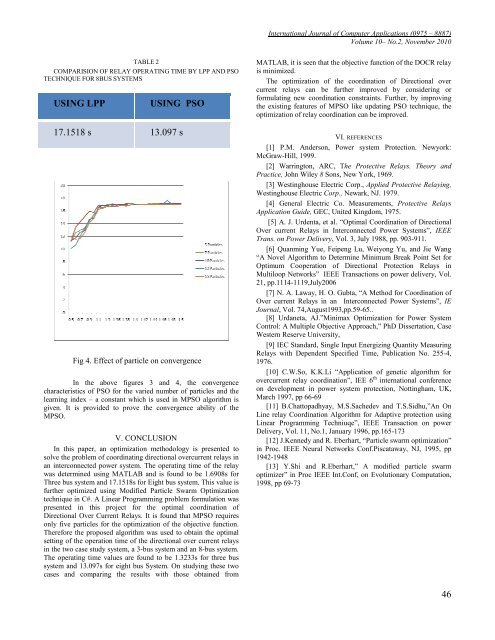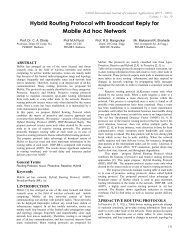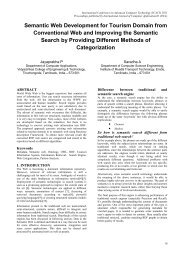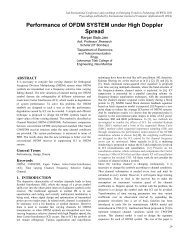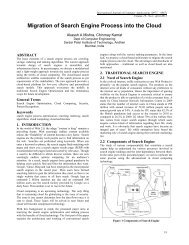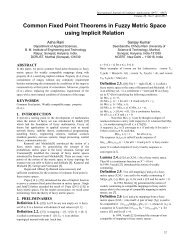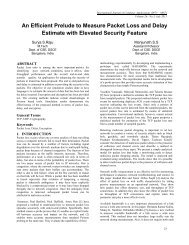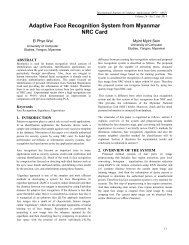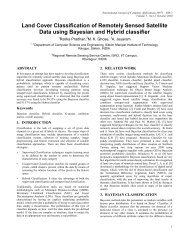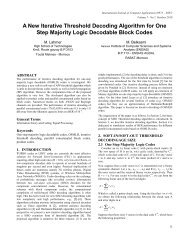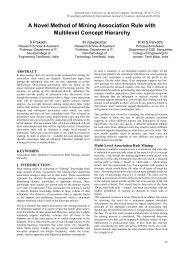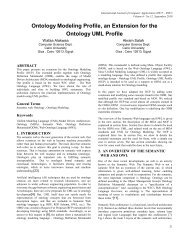Optimal Coordination of Directional Overcurrent Relays using ...
Optimal Coordination of Directional Overcurrent Relays using ...
Optimal Coordination of Directional Overcurrent Relays using ...
You also want an ePaper? Increase the reach of your titles
YUMPU automatically turns print PDFs into web optimized ePapers that Google loves.
International Journal <strong>of</strong> Computer Applications (0975 – 8887)<br />
Volume 10– No.2, November 2010<br />
TABLE 2<br />
COMPARISION OF RELAY OPERATING TIME BY LPP AND PSO<br />
TECHNIQUE FOR 8BUS SYSTEMS<br />
USING LPP<br />
USING PSO<br />
17.1518 s 13.097 s<br />
Fig 4. Effect <strong>of</strong> particle on convergence<br />
In the above figures 3 and 4, the convergence<br />
characteristics <strong>of</strong> PSO for the varied number <strong>of</strong> particles and the<br />
learning index – a constant which is used in MPSO algorithm is<br />
given. It is provided to prove the convergence ability <strong>of</strong> the<br />
MPSO.<br />
V. CONCLUSION<br />
In this paper, an optimization methodology is presented to<br />
solve the problem <strong>of</strong> coordinating directional overcurrent relays in<br />
an interconnected power system. The operating time <strong>of</strong> the relay<br />
was determined <strong>using</strong> MATLAB and is found to be 1.6908s for<br />
Three bus system and 17.1518s for Eight bus system. This value is<br />
further optimized <strong>using</strong> Modified Particle Swarm Optimization<br />
technique in C#. A Linear Programming problem formulation was<br />
presented in this project for the optimal coordination <strong>of</strong><br />
<strong>Directional</strong> Over Current <strong>Relays</strong>. It is found that MPSO requires<br />
only five particles for the optimization <strong>of</strong> the objective function.<br />
Therefore the proposed algorithm was used to obtain the optimal<br />
setting <strong>of</strong> the operation time <strong>of</strong> the directional over current relays<br />
in the two case study system, a 3-bus system and an 8-bus system.<br />
The operating time values are found to be 1.3233s for three bus<br />
system and 13.097s for eight bus System. On studying these two<br />
cases and comparing the results with those obtained from<br />
MATLAB, it is seen that the objective function <strong>of</strong> the DOCR relay<br />
is minimized.<br />
The optimization <strong>of</strong> the coordination <strong>of</strong> <strong>Directional</strong> over<br />
current relays can be further improved by considering or<br />
formulating new coordination constraints. Further, by improving<br />
the existing features <strong>of</strong> MPSO like updating PSO technique, the<br />
optimization <strong>of</strong> relay coordination can be improved.<br />
VI. REFERENCES<br />
[1] P.M. Anderson, Power system Protection. Newyork:<br />
McGraw-Hill, 1999.<br />
[2] Warrington, ARC, The Protective <strong>Relays</strong>. Theory and<br />
Practice, John Wiley 8 Sons, New York, 1969.<br />
[3] Westinghouse Electric Corp., Applied Protective Relaying,<br />
Westinghouse Electric Corp., Newark, NJ. 1979.<br />
[4] General Electric Co. Measurements, Protective <strong>Relays</strong><br />
Application Guide, GEC, United Kingdom, 1975.<br />
[5] A. J. Urdenta, et al. “<strong>Optimal</strong> <strong>Coordination</strong> <strong>of</strong> <strong>Directional</strong><br />
Over current <strong>Relays</strong> in Interconnected Power Systems”, IEEE<br />
Trans. on Power Delivery, Vol. 3, July 1988, pp. 903-911.<br />
[6] Quanming Yue, Feipeng Lu, Weiyong Yu, and Jie Wang<br />
“A Novel Algorithm to Determine Minimum Break Point Set for<br />
Optimum Cooperation <strong>of</strong> <strong>Directional</strong> Protection <strong>Relays</strong> in<br />
Multiloop Networks” IEEE Transactions on power delivery, Vol.<br />
21, pp.1114-1119,July2006<br />
[7] N. A. Laway, H. O. Gubta, “A Method for <strong>Coordination</strong> <strong>of</strong><br />
Over current <strong>Relays</strong> in an Interconnected Power Systems”, IE<br />
Journal, Vol. 74,August1993,pp.59-65..<br />
[8] Urdaneta, AJ.”Minimax Optimization for Power System<br />
Control: A Multiple Objective Approach,” PhD Dissertation, Case<br />
Western Reserve University,<br />
[9] IEC Standard, Single Input Energizing Quantity Measuring<br />
<strong>Relays</strong> with Dependent Specified Time, Publication No. 255-4,<br />
1976.<br />
[10] C.W.So, K.K.Li “Application <strong>of</strong> genetic algorithm for<br />
overcurrent relay coordination”, IEE 6 th international conference<br />
on development in power system protection, Nottingham, UK,<br />
March 1997, pp 66-69<br />
[11] B.Chattopadhyay, M.S.Sachedev and T.S.Sidhu,”An On<br />
Line relay <strong>Coordination</strong> Algorithm for Adaptive protection <strong>using</strong><br />
Linear Programming Techniuqe”, IEEE Transaction on power<br />
Delivery, Vol. 11, No.1, January 1996, pp.165-173<br />
[12] J.Kennedy and R. Eberhart, “Particle swarm optimization”<br />
in Proc. IEEE Neural Networks Conf.Piscataway, NJ, 1995, pp<br />
1942-1948<br />
[13] Y.Shi and R.Eberhart,” A modified particle swarm<br />
optimizer” in Proc IEEE Int.Conf, on Evolutionary Computation,<br />
1998, pp 69-73<br />
46


